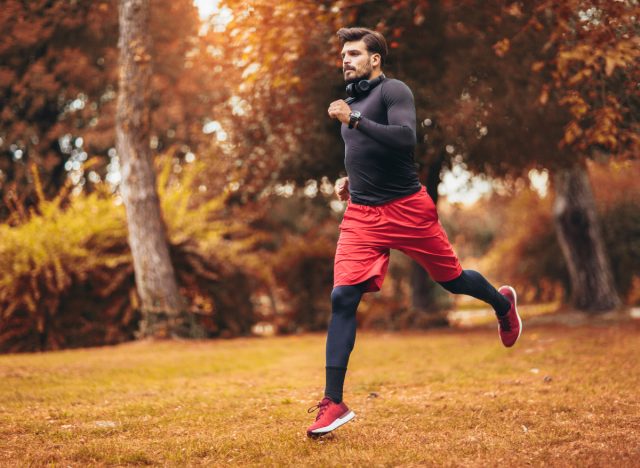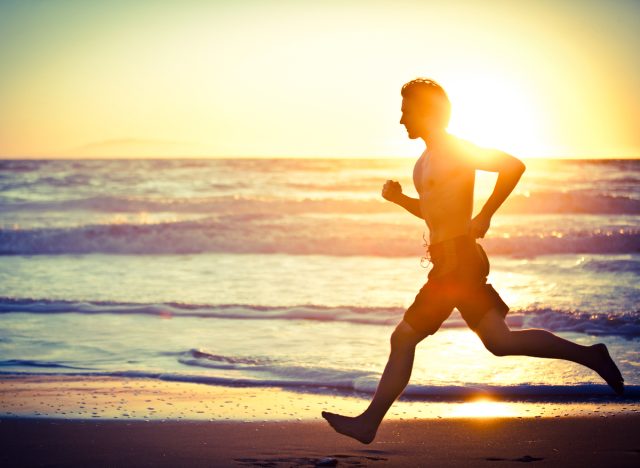Is Running Every Day Enough Exercise to Stay Fit?

You lace up your sneakers every morning, hit the pavement, and feel that rush of accomplishment as you complete another daily run. Since I first passed my personal training course almost 4 decades ago, I’ve seen all sorts of fitness trends come and go, from the gimmicky (I’m looking at you Shake Weights) to the ones with solid foundations like Insanity or P90x. In all that time, one form of cardio has remained consistently popular. Running will always be in every trainer’s toolkit as it’s a fundamental human movement, it doesn’t require specialist equipment, and it’s very easy to scale up or down in difficulty depending on the ability of the trainee. But while that daily jog feels great and certainly beats sitting on the couch, you might wonder if it’s giving you everything your body needs to stay truly fit. Here’s what you need to know about whether your daily running habit is enough to keep you in peak condition.
Why You’re Drawn to Running as Your Main Exercise

With so many fitness options available today, why do people turn to running as their go-to exercise for staying fit?
- It’s incredibly straightforward. Running wins because it’s straightforward: no gym membership, no equipment beyond decent trainers, no learning complex movements. You simply open your front door and go. That simplicity removes barriers that stop people from exercising consistently.
- It’s time-efficient. Running is incredibly time-efficient – and this is super appealing to a lot of people. Running a solid 25 minutes delivers cardio benefits that can take up to an hour for other activities. Meaningful exercise can be fit into lunch breaks or early mornings without massively affecting your whole day.
- The mental benefits keep you hooked. The mental benefits people see are what keep them hooked long-term. Running releases endorphins – chemicals in the brain that genuinely help improve mood and lower anxiety. This is what’s often referred to as the runner’s high. Many runners describe their training as moving meditation – a repetitive motion that doesn’t require huge focus and helps clear brain clutter and provide thinking time. After a stressful day, running can be a huge emotional release, rather than just exercise.
- Progress is measurable. Progress in running is a tangible thing. We can measure improvements in our pace, distance, or how we feel during our training session. This feedback loop is super motivating as we see concrete evidence of our fitness improving unlike some activities at the gym where progress isn’t as easy to spot.
RELATED: 4 Daily Moves That Target Belly Overhang in 30 Days After 50
What Your Daily Runs Are Missing

A daily run covers your cardiovascular fitness incredibly well, but it does leave big gaps in your overall fitness. Heart, lung, and leg endurance will be top-notch. However, fitness is more than just cardio conditioning.
- Upper-body strength gets neglected. Running completely neglects upper-body strength. Your arms, shoulders, chest, and back won’t get any stronger and won’t develop the strength needed for lifting/carrying/pushing. This is a problem as you age, as daily tasks become more of a challenge without enough upper-body strength.
- Flexibility and mobility actually decrease. Running-only routines actually generally cause a decrease in flexibility and mobility. Your hip flexors, calves, and hamstrings become tight from repeated forward motion. If you don’t add stretching or mobility work, the range of motion will reduce, potentially leading to movement restrictions and/or injury.
- Balance and coordination remain limited. Balance and coordination development are limited because running happens in one plane of movement. You move forward repeatedly but miss lateral and rotational challenges that real life demands. This leaves you less prepared for activities requiring quick direction changes or multi-directional stability.
- Core strength improvement is minimal. Running does give a slight improvement to core strength, but it’s not comparable to what dedicated core training can provide. Having a strong core reduces back pain, encourages better posture, and improves your performance in all activities. Running alone can’t deliver this.
How Your Daily Runs Help You Lose Weight

- Burns calories fast. Daily running is phenomenal for losing fat as it burns a significant amount of calories very quickly. Depending on how much you weigh and the pace you run, 30 mins of running burns between 300 and 600 calories. This burn helps create the deficit needed for fat loss when combined with healthy eating.
- Keeps your metabolism elevated. Your metabolism stays boosted after running sessions. This afterburn effect means you continue burning extra calories for hours post-workout. Higher intensity runs create longer-lasting metabolic boosts, making your daily runs work for you even while resting.
- Trains your body to burn fat efficiently. Running makes our bodies burn fat more efficiently. People who run regularly develop an ability to more effectively use stored fat as fuel while they exercise rather than just relying on energy from carbs. This metabolic adaptation is a big help with long-term weight management.
- Creates better lifestyle habits. The routine aspect also helps with weight control. People who run daily often make better food choices because they don’t want to undermine their exercise efforts. The daily commitment to running frequently leads to overall healthier lifestyle habits that support weight management.
What Happens to Your Heart When You Run Daily

- Your heart becomes stronger. Your heart becomes a powerhouse with daily running. The cardiac muscle grows stronger and slightly larger, pumping significantly more blood with each beat. This adaptation drops your resting heart rate and speeds up recovery after any physical effort – you’ll bounce back faster from everything from sprint intervals to carrying heavy shopping bags.
- Your breathing transforms. Breathing transforms completely. Your diaphragm and intercostal muscles develop strength while lung capacity expands. More importantly, your body gets better at extracting oxygen from each breath. The first place you’ll notice this isn’t during runs – it’s when everyday tasks like climbing stairs suddenly feel effortless.
- Blood pressure improves gradually. Blood pressure improvements happen gradually but consistently. Your strengthened heart doesn’t need to work as hard to circulate blood, reducing pressure on artery walls. Combined with better circulation, this cardiovascular remodeling cuts your risk of heart attacks and strokes substantially.
- Your blood chemistry shifts positively. Your blood chemistry shifts in positive directions. HDL cholesterol – the type that protects arteries – typically rises while dangerous LDL cholesterol and triglycerides fall. Running also makes your cells more responsive to insulin, keeping blood sugar stable and reducing diabetes risk.
- New blood vessels actually grow. New blood vessels actually grow throughout your body. Running triggers capillary development, creating additional pathways for oxygen and nutrients to reach tissues. This improved circulation doesn’t just help your legs during runs – it benefits your brain, organs, and healing processes everywhere in your body.
The Truth About Building Muscle Through Running

- Leg strength improves modestly. Running develops decent leg strength in your calves, hamstrings, glutes, and quads. Hills amplify this effect as your muscles push against gravity with each step. But don’t expect the strength gains you’d get from squats or deadlifts – running’s strength benefits are modest at best.
- You build endurance, not raw power. What running really builds is muscular endurance, not raw power. Your leg muscles learn to fire repeatedly for extended periods rather than generating maximum force. It’s like training your muscles to be efficient marathon workers rather than powerful sprinters.
- Upper body gains are minimal. Your upper body barely gets stronger from running. Yes, your arms pump and your core stabilizes, but the resistance is too light to stimulate meaningful strength gains. These muscles work more like assistants, helping with balance and rhythm rather than doing heavy lifting.
- Imbalances can develop. Daily running can actually create problems if you don’t balance it out. Your hip flexors and calves get overdeveloped while your glutes and shins lag behind. This imbalance is a recipe for injury – tight hip flexors pull on your lower back, weak glutes don’t support your pelvis properly.
- Add resistance training for real strength. If you want real strength alongside your running, add resistance training twice a week minimum. Focus on movements that complement running – squats, deadlifts, single-leg work, and upper body exercises. This combination gives you the cardiovascular benefits of daily running plus the strength gains that running simply can’t deliver.
How Long You Should Run Each Day

- Aim for 20-30 minutes. Twenty to thirty minutes is a good range to aim for. You get great cardiovascular benefits without hugely impacting your recovery systems or hammering your joints. For most of us, this feels psychologically manageable while delivering actual improvements to our fitness.
- Start shorter if you’re new. Start with shorter sessions if you’re new to running. Start out with 10-15 minutes and add a few minutes each week. Your heart, lungs, muscles, and joints all need time to adapt. Push too hard, too fast, and you’ll end up injured or burnt out before the habit sticks.
- Focus on effort over time. Focus on effort level more than the clock. A tough 20-minute run often beats an easy 45-minute plod for fitness gains. Mix your daily intensities – most runs should feel comfortable enough to chat during, with harder sessions sprinkled in occasionally.
- Listen to your body daily. Listen to your body when you’re deciding on exactly how long to run each day. Some mornings you’ll feel amazing and want to run longer, other days, a quarter of an hour might be your limit. Listen to those signals rather than trying to stick to arbitrary time targets. Running for 20 minutes consistently each day for 7 days is better than running three-hour-long sessions that leave you dreading even lacing up your shoes the next workout.
When You Should Schedule Your Runs

- Morning runs work better for most people. Morning runs work better for most beginners because they eliminate decision fatigue and daily obstacles. Your willpower is strongest first thing, before work stress and family demands drain your energy. Morning running also prevents excuses from accumulating throughout the day.
- However, your body needs extra preparation in the morning. Muscle temperature is lower and joints are stiffer after sleep, increasing injury risk slightly. Spend additional time warming up with walking and gentle movements before increasing pace.
- Evening runs feel easier physically. Evening runs can feel easier physically because your body temperature is naturally higher, and joints are more mobile from daily movement. Some people also find evening running helps process daily stress and transition into relaxation mode.
- The biggest evening challenge is consistency. Work deadlines, family obligations, and social plans interfere with evening exercise more than morning sessions. Evening running can also energize some people too much before sleep, potentially affecting rest quality.
- Choose the time you can stick to. Choose the time slot you can protect most consistently. A mediocre time that you stick to beats perfect timing that you frequently skip. Most successful daily runners eventually gravitate toward morning sessions because life interferes less with early workouts.
How Running Compares to Walking for Your Fitness

- Running delivers faster results. Running delivers cardiovascular improvements and calorie burn much faster than walking. A 30-minute run typically burns twice the calories of a 30-minute walk and creates greater heart and lung adaptations. For time-conscious people, running provides better fitness returns on investment.
- Walking offers a gentler progression. Walking offers a gentler progression for beginners or people with joint concerns. It provides cardiovascular benefits with less impact on the knees, hips, and ankles. Walking is also more sustainable psychologically – sessions don’t feel intimidating or exhausting.
- Many runners start with walking. Many successful runners started with walking or walk-run intervals. If you can’t run continuously for 10 minutes, walking builds the fitness foundation needed before progressing to running. This staged approach prevents injury and builds confidence.
- Both have mental health benefits. Both activities provide mental health benefits and can become enjoyable daily habits. Walking might suit people who prefer socializing during exercise or focusing on their surroundings, while running provides more intense endorphin release and time efficiency. You don’t need to choose permanently – walking on recovery days complements running perfectly.
Looking for more easy ways to lose fat? Here’s How Long Your Walking Workout Should Be To Shrink Belly Fat.